The Haiku Houses of Japan
An overview of Japanese House Design and why they are like solid Haiku Poems.
As a little follow up to some reading and thinking around the books Lost in Japan and In Praise of Shadows I think its worth looking at an aspect of Japanese architecture I love and I think could be understood better through the lens of the above books and a little analogy which might bring some different insights.
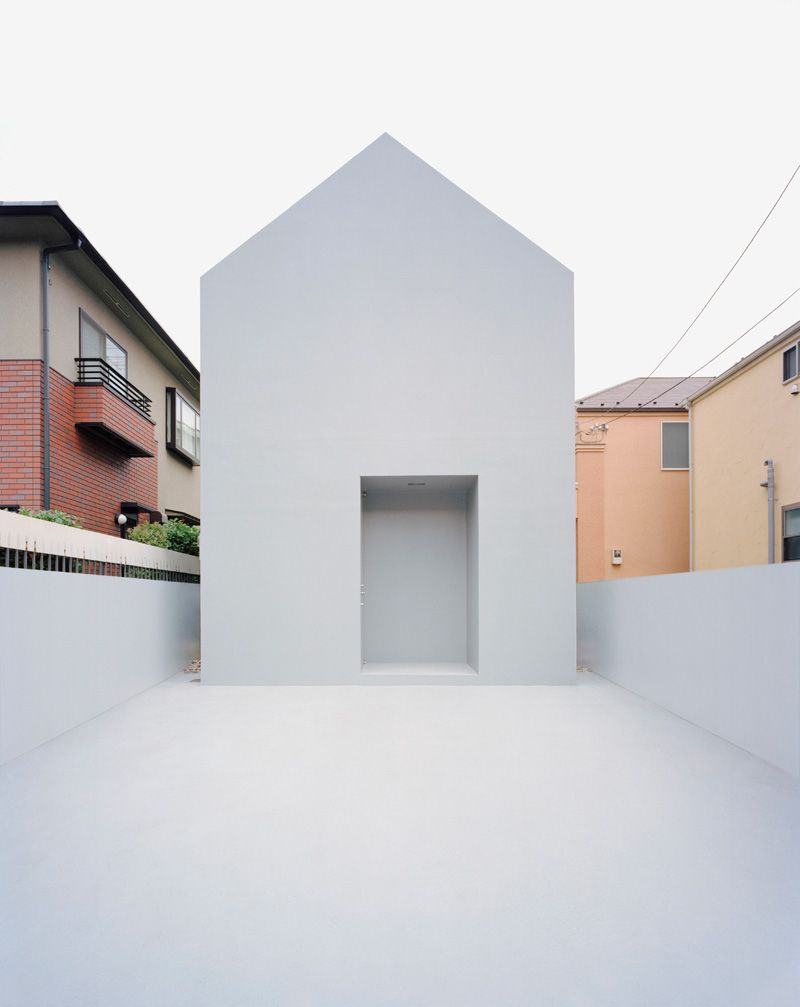
Ghost House by Datar Architecture (Photograph by Takeshi Yamagishi)
Japanese Houses are Different
The first thing to note is that Japanese Houses are different. Really, really different.
And it’s not just a surface difference but runs through everything about them. There are houses with no windows, with no walls, or with no inside walls or how about a house with no doors.
Beyond the headline grabbing nature of a bunch of experimental houses family homes can be just as weird. Just to give a couple of examples The Open Sky House by YSAA where the living room of the house is an open courtyard. If it’s raining during your favourite T.V. program you will get wet.
Another example is the The House in Higashisumiyoshi by Horibe Associates which has no windows and an open courtyard inside where you can see the sky and be outside but where in the whole house there is no contact at all with the city outside. Light and nature is completely filtered through the walls of the building and nothing of the city is allowed through. And it appears the feeling is mutual the city seems not to care about the buildings that make it up. A photo shows the power lines and street lights on a pylon just in front of the building on the Main Street elevation.
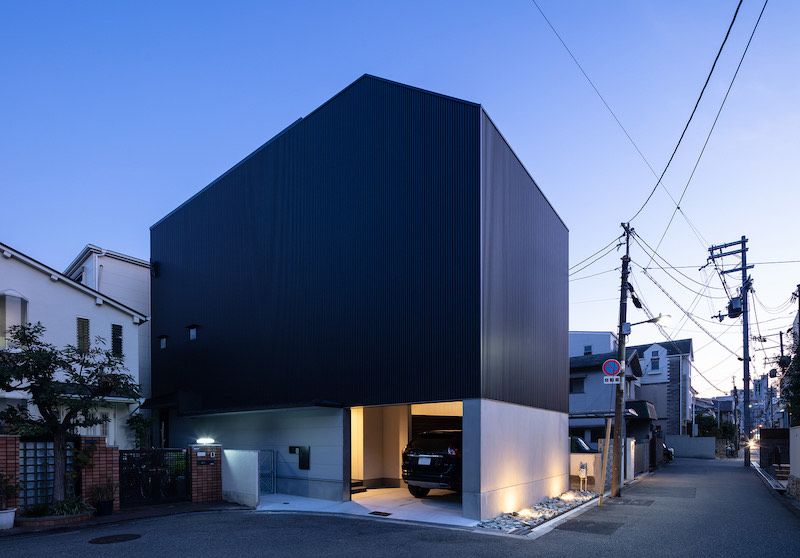
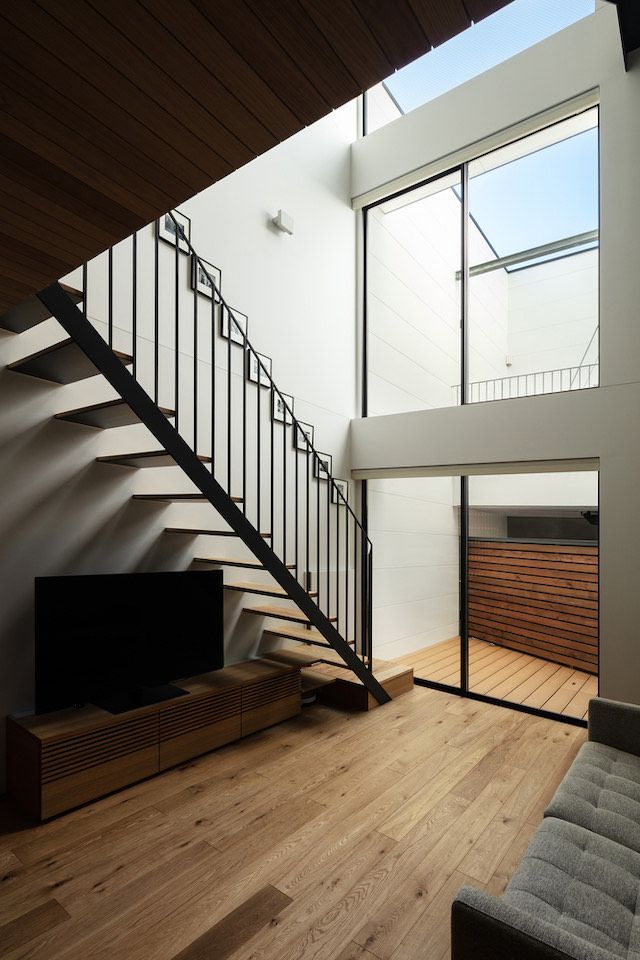
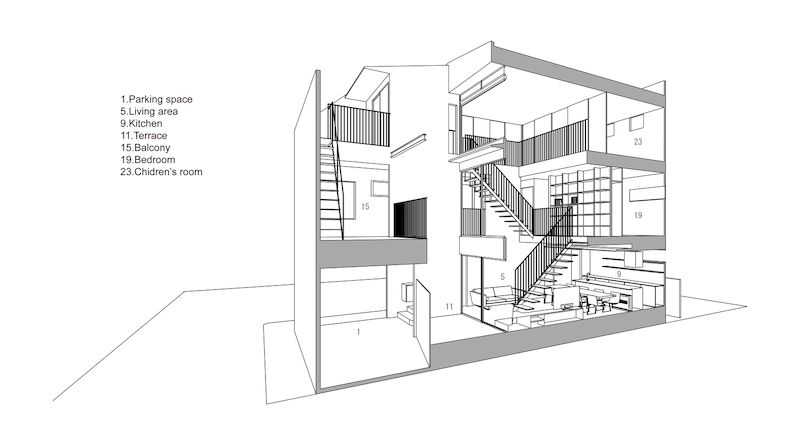
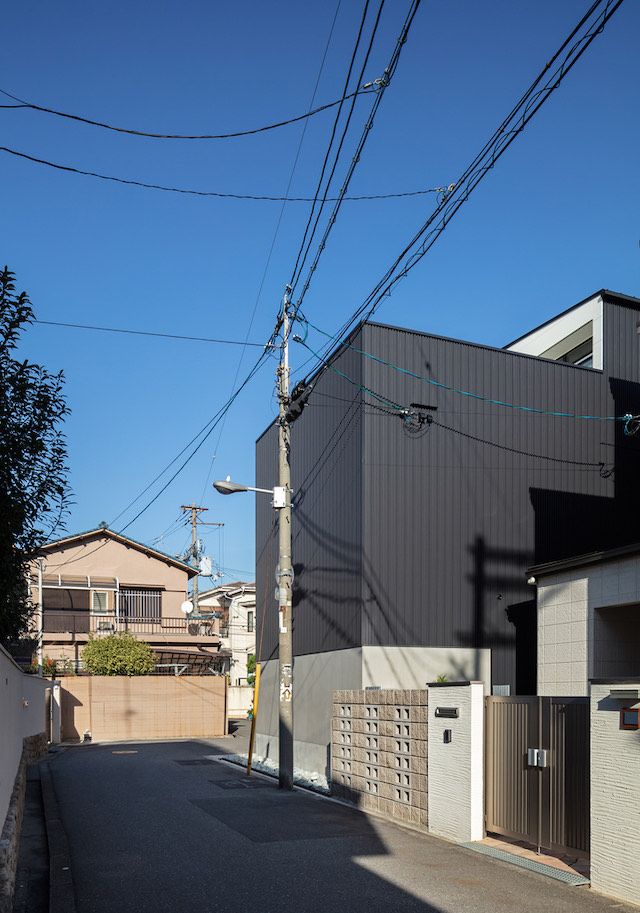
No other country in the world has such a large amount of innovative strange, ugly and beautiful houses. Why is this, why do they seemingly embrace nature on the inside but often ignore or completely exclude their surroundings, the city and neighbourhood in which they are built?
The Japanese Houses and Time
Historically houses have been temporary in nature in Japan because of the various earthquakes, tsunamis and fires which have occurred throughout their history.
This leads also to a view of architecture and buildings which sees them differently in time than in the West. In The West for instance the great Cathedrals built in the last thousand years have been built in stone and meant to last for the ages.
In Japan one of their greatest temple the Ise Jingu grand shrine in Mie Prefecture is torn down and then rebuilt every twenty years. They have been doing that for 1300 years so far. So a buildings relationship to time is seen differently in Japan.
The physical embodiment of the building and its permanence are less clearly linked.
Japanese Traditional Houses
The Japanese House has its origin in asian housing with large overhanging roofs with lightweight minimal walls. Nature and the elements were always present. Japanese weather, consists of large variations in the seasons from humid heat in the summer to bitter cold and snow in the Winter.
The Japanese Housemarket
The Japanese House Market is very different from most others across the world.
Unlike in other countries, Japanese homes gradually depreciate over time, becoming completely valueless within 20 or 30 years. When someone moves out of a home or dies, the house, unlike the land it sits on, has no resale value and is typically demolished. This scrap-and-build approach is a quirk of the Japanese housing market that can be explained variously by low-quality construction to quickly meet demand after the second world war, repeated building code revisions to improve earthquake resilience and a cycle of poor maintenance due to the lack of any incentive to make homes marketable for resale.
-Raze, rebuild, repeat: why Japan knocks down its houses after 30 years
The Building code revision for Earthquake standards is a good example, for last 100 years after every large earthquake the Japanese have updated their codes. 1915, 1950, 1971, 1981, 2000 (ref) there have been major revisions.
But today many homes that meet these standards are still demolished. Land prices have remained high particularly in the cities. This means that the Japanese often don’t really take care of their Houses on the outside. Once they have been built why maintain something that is fast becoming worthless. Maybe this contributes to not caring about external looks in the city also?
There are more Architects in Japan per head of population than in any country anywhere in the world, five times as many as the UK and over seven times as many as the U.S.A.
You could add a few other factors that contribute, wooden houses for tax purposes loose their value after 22 years, there has been a population decrease in Japan that is speeding up.
Japanese Cities
With a couple of exceptions in Japan of cities that were modelled according to Chinese layouts, Japanese cities are not planned but have grown up organically. With the quick growth and rebuild after the War there seems to have been a blind spot developed to the quality of the urban life there. It’s clear to read in the many lamentations in Lost Japan by Alex Kerr. Post War Japan has ignored its history, nature and urban environment in its rush to build and rebuild.
Environment For Innovation
All these factors taken together make for a unique house market. So with much building, which will devalue fast, innovation and risk taking won’t have the penalties on the house market they normally would. Moreover architects can be more responsive to the particular wishes of the client. In the land of social conformity there is an outlet for creativity and personality which can be more deeply explored in Japan than almost anywhere else in the world.
But while the above factor explain why Japanese houses are able to be more free and individualistic it doesn’t really explain why they are like they are. Often very minimalistic they are somehow different from Western ‘Less is More’ Minimalism. It is a more intentional or focused sort of Minimalism.
A Haiku House
Perhaps you could look at Japanese houses as a type of Haiku. A Haiku is a three line poem each line with 5 then 7 then 5 syllables. There should be a kireji or cutting word included somewhere inside and the poet is free to use punctuation to help form his Haiku. Part of the Haikus power and beauty comes from its limits. The limits of the size and form of the poem mean the poet must convey meaning and suggest other meanings with a focus and directness that otherwise would not be required of them.
So maybe the Japanese House that shields from the city, endlessly creative but minimal is a kind of Haiku. A small beautiful and limited spacial poem. It limits itself by excluding the surroundings like the form of a Haiku and just like a Haiku it employs a kireji or strong concept to articulate the design, a way of living. Theses houses are often small like the short Haiku and focussed so they are conceptually minimal unlike Western minimalism which is formally minimal. A Haiku house fits.
Lets look at one of the great small houses of Japan through this lens to see if it helps us understand the building Better. I am going to pick one of my favourite buildings.
The Azuma House by Tadao Ando
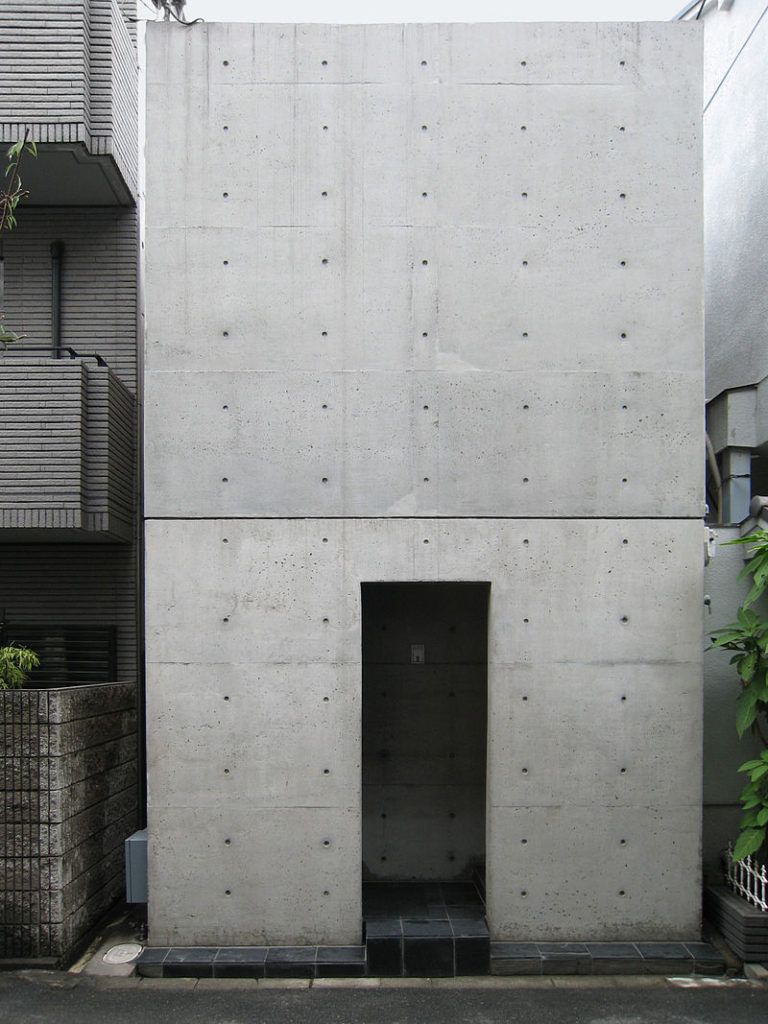
Azuma House by Tadao Ando (Photo by Oiuysdfg)
This house built in 1976 is the design that launched Tadao Ando in his career which takes in the 1995 Pritzker prize. The House is an inspiration to a generation of Architects not just from Japan. But it’s so strange.
Firstly it is a beautiful three way equal split of volumes. The front and back volume are separated by the central courtyard space. The block at the front and back each have two rooms, one per floor. There is a bridge between the upper floors across the courtyard and a staircase also in the courtyard.
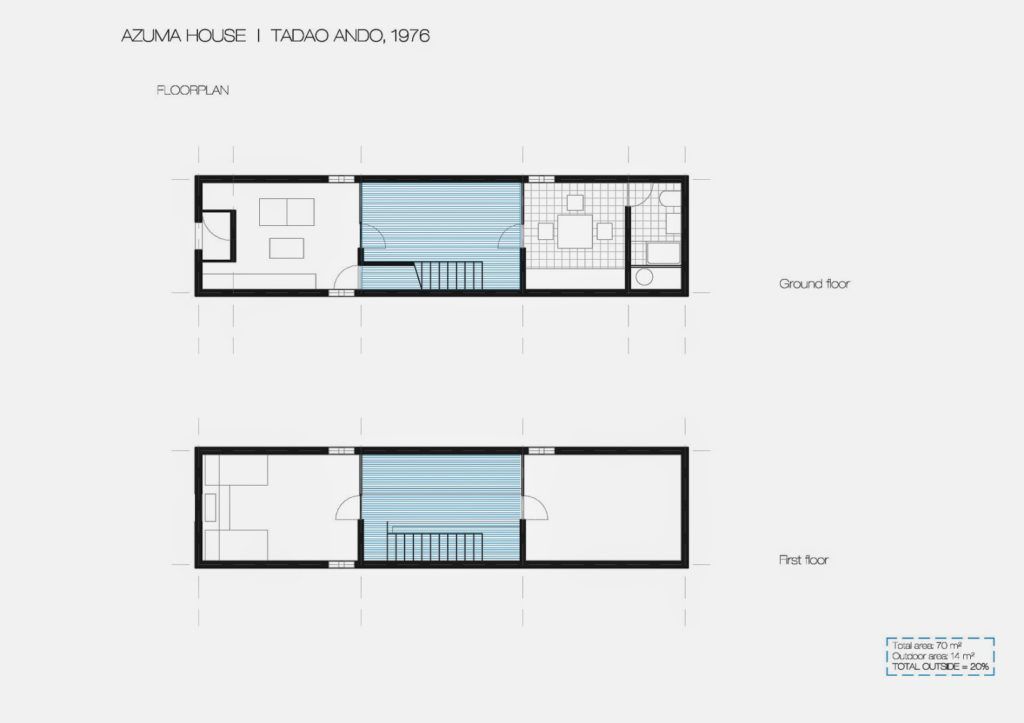
Azuma House Plan
The entrance of the house leads you to the living room, the kitchen and bathroom are across the courtyard at the back. To go to the bedroom you must again go into the courtyard and go up the stairs. The study or spare room is a trip back through the courtyard using the bridge.
There is no movement from one room to another without going outside in the courtyard. If it a sunny day and you want to go between the living room and the kitchen or if there is a storm in the middle of the night and you need to go to the bathroom you will have to go outside.The house has no insulation either you have to heat the room you are in.
At the time (mid-1970s), I thought of residential design as the creation of a place where people can dwell as they themselves intend. If they feel cold, they can put on an additional layer of clothing. If they feel warm, they can discard extraneous clothing. What is important is the space be, not a device for environmental control, but something definite and responsive to human life… No matter how advanced society becomes, institutionally or technologically, a house in which nature can be sensed represents for me the ideal environment in which to live.
- Ref
Also the front elevation is plain concrete. There are no windows at all to the outside and no windows at all to the inside just glazed walls.
The courtyard in the middle of the house is also treated in the same way. You are subject to nature and you can see the sun anf the light an shadow play on the plain walls but there are no plants its a manmade surroundings here. Its a meditation on nature on its effect on you but its presented as part of the house it’s also manmade in a way.
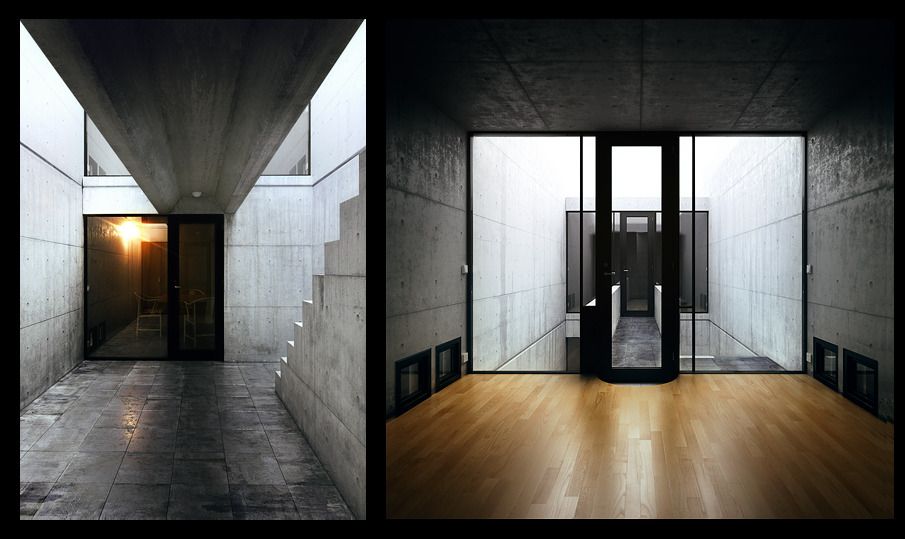
Azuma House Interior
All these things make this house challenging, forceful and maybe not the easiest house to actually live in. It has no relationship to the city that surrounds it and while it exposes the inhabitants to the forces of nature they are filtered by the building as expressions of the Architecture.
An old silent pond…
A frog jumps into the pond,
splash! Silence again.-Matsuo Basho